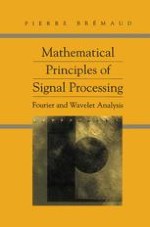2002 | Buch
Über dieses Buch
Fourier analysis is one of the most useful tools in many applied sciences. The recent developments of wavelet analysis indicates that in spite of its long history and well-established applications, the field is still one of active research.
This text bridges the gap between engineering and mathematics, providing a rigorously mathematical introduction of Fourier analysis, wavelet analysis and related mathematical methods, while emphasizing their uses in signal processing and other applications in communications engineering. The interplay between Fourier series and Fourier transforms is at the heart of signal processing, which is couched most naturally in terms of the Dirac delta function and Lebesgue integrals.
The exposition is organized into four parts. The first is a discussion of one-dimensional Fourier theory, including the classical results on convergence and the Poisson sum formula. The second part is devoted to the mathematical foundations of signal processing - sampling, filtering, digital signal processing. Fourier analysis in Hilbert spaces is the focus of the third part, and the last part provides an introduction to wavelet analysis, time-frequency issues, and multiresolution analysis. An appendix provides the necessary background on Lebesgue integrals.
Anzeige
